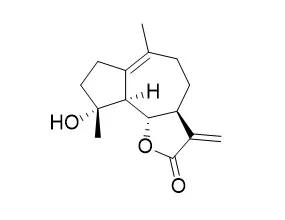| Description: |
Micheliolide has antineoplastic, anti-inflammatory and immunomodulatory effects, it inhibits various inflammatory response and may serve as a neuroprotective agent in neuroinflammation-related neurodegenerative disorders. Micheliolide has potential as a candidate drug for the treatment of diabetic nephropathy, it can effectively attenuate the high glucose-stimulated activation of NF-κB, the degradation of IκBα, and the expression of MCP-1, TGF-β1 and FN in rat mesangial cells (MCs). Micheliolide also ameliorates liver steatosis by upregulating PPAR-γ expression, thereby inhibiting NF-κB-mediated inflammation and activating AMPK/mTOR-dependent autophagy.
|
| Targets: |
PPAR | p65 | NF-kB | IkB | AMPK | mTOR | COX | TNF-α | IL Receptor | NO | NOS | Akt | JNK | p38MAPK | ERK | HO-1 | Nrf2 | PI3K | ROS | TGF-β/Smad | IKK |
| In vitro: |
| PLoS One. 2017 Oct 17;12(10):e0186592. | | Micheliolide suppresses LPS-induced neuroinflammatory responses.[Pubmed: 29040306 ] | Microglia-involved neuroinflammation is thought to promote brain damage in various neurodegenerative disorders. Thus, inhibition of microglial over-activation may have a therapeutic benefit for the treatment of neurodegenerative disorders. Micheliolide (MCL) is a sesquiterpene lactone which inhibits various inflammatory response. However, whether MCL can inhibit neuroinflammation caused by LPS-activated BV2 microglia has not yet been explored.
METHODS AND RESULTS:
In this study, we demonstrated that treatment of BV2 cells with MCL significantly repressed LPS-stimulated nitric oxide synthase (iNOS) and cyclooxygenase-2 (COX-2) expression, as well as tumor necrosis factor-alpha (TNF-α), interleukin-6 (IL-6) and nitric oxide (NO) induction. MCL also attenuated mRNA levels of multiple pro-inflammatory cytokines and mediators such as iNOS, COX-2, TNF-α, IL-6 and IL-1β. Mechanistic studies revealed that MCL suppressed LPS-stimulated the activation of IκBα/NF-κB pathway and Akt pathway. Moreover, MCL inhibited LPS-induced the activition of c-Jun N-terminal kinase (JNK), p38 MAPK kinase, and extracellular signal-regulated kinases 1/2 (ERK1/2). Meanwhile, MCL markedly promoted antioxidant protein heme oxygenase-1 (HO-1) expression by enhancing NF-E2-related factor 2 (Nrf2) activity.
CONCLUSIONS:
Together, our results imply that MCL may serve as a neuroprotective agent in neuroinflammation-related neurodegenerative disorders. | | Molecules. 2013 Oct 21;18(10):13061-77. | | Sesquiterpene lactones and their derivatives inhibit high glucose-induced NF-κB activation and MCP-1 and TGF-β1 expression in rat mesangial cells.[Pubmed: 24152676 ] | Diabetic nephropathy (DN) is one of the most common and serious chronic complications of diabetes mellitus, however, no efficient clinical drugs exist for the treatment of DN.
METHODS AND RESULTS:
We selected and synthesized several sesquiterpene lactones (SLs), and then used the MTT assay to detect rat mesangial cells (MCs) proliferation, ELISA to measure the expression level of monocyte chemoattractant protein-1 (MCP-1), transforming growth factor beta (TGF-β1) and fibronectin(FN), real-time fluorescent quantitative PCR analysis to measure the MCP-1 and TGF-β1 gene expression, western blot to detect the level of IκBα protein and EMSA to measure the activation of nuclear factor kappa B (NF-κB). We discovered that SLs, including parthenolide (PTL), Micheliolide (MCL), arglabin, and isoalantolactone (IAL), as well as several synthetic analogs of these molecules, could effectively attenuate the high glucose-stimulated activation of NF-κB, the degradation of IκBα, and the expression of MCP-1, TGF-β1 and FN in rat mesangial cells (MCs).
CONCLUSIONS:
These findings suggest that SLs and their derivatives have potential as candidate drugs for the treatment of DN. |
|
| In vivo: |
| Int Immunopharmacol. 2018 Jun;59:197-208. | | Micheliolide alleviates hepatic steatosis in db/db mice by inhibiting inflammation and promoting autophagy via PPAR-γ-mediated NF-кB and AMPK/mTOR signaling.[Pubmed: 29656210] | The anti-inflammatory, immunomodulatory, and anticancer effects of Micheliolide (MCL) isolated from Michelia champaca were previously reported, but its role and underlying mechanisms in relieving liver steatosis remain unclear.
METHODS AND RESULTS:
Herein, we investigated the effects of MCL on hepatic steatosis using a db/db mouse model and lipid mixture (LM)-induced AML12 and LO2 cells. The body and liver weights, food consumption, lipid content and liver aminotransferase levels in serum, the lipid content and inflammatory cytokine levels in liver tissue, and the extent of hepatic steatosis in db/db mice were increased compared with those in db/m mice, and these increases were reversed by MCL treatment. Similarly, MCL also attenuated the inflammatory responses and lipid accumulation in LM-treated AML12 and L02 cells by upregulating PPAR-γ and decreasing p-IкBα and p-NF-κB/p65, thereby inhibiting the NF-κB pathway and reducing lipotoxicity. Furthermore, MCL administration increased LC3B, Atg7 and Beclin-1 expression and the LC3B-II/I ratio in db/db mouse livers and LM-treated AML12 and L02 cells, and these MCL-induced increases were mediated by the activation of PPAR-γ and p-AMPK and inhibition of p-mTOR and induce autophagy. These effects were blocked by PPAR-γ and AMPK inhibitors.
CONCLUSIONS:
Our findings suggest that MCL ameliorates liver steatosis by upregulating PPAR-γ expression, thereby inhibiting NF-κB-mediated inflammation and activating AMPK/mTOR-dependent autophagy. | | Oncotarget. 2016 Oct 4;7(40):65012-65023. | | Antineoplastic effects and mechanisms of micheliolide in acute myelogenous leukemia stem cells.[Pubmed: 27542251] | Leukemic stem cells (LSCs) greatly contribute to the initiation, relapse, and multidrug resistance of leukemia. Current therapies targeting the cell cycle and rapidly growing leukemic cells, including conventional chemotherapy, have little effect due to the self-renewal and differentiated malignant cells replenishment ability of LSCs despite their scarce supply in the bone marrow. Micheliolide (MCL) is a natural guaianolide sesquiterpene lactone (GSL) which was discovered in michelia compressa and michelia champaca plants, and has been shown to exert selective cytotoxic effects on CD34+CD38- LSCs.
METHODS AND RESULTS:
In this study, we demonstrate that DMAMCL significantly prolongs the lifespan of a mouse model of human acute myelogenous leukemia (AML). Mechanistic investigations further revealed that MCL exerted its cytotoxic effects via inhibition of NF-κB expression and activity, and by generating intracellular reactive oxygen species (ROS).
These results provide valuable insight into the mechanisms underlying MCL-induced cytotoxicity of LSCs, and support further preclinical investigations of MCL-related therapies for the treatment of AML. |
|






 Cell. 2018 Jan 11;172(1-2):249-261.e12. doi: 10.1016/j.cell.2017.12.019.IF=36.216(2019)
Cell. 2018 Jan 11;172(1-2):249-261.e12. doi: 10.1016/j.cell.2017.12.019.IF=36.216(2019) Cell Metab. 2020 Mar 3;31(3):534-548.e5. doi: 10.1016/j.cmet.2020.01.002.IF=22.415(2019)
Cell Metab. 2020 Mar 3;31(3):534-548.e5. doi: 10.1016/j.cmet.2020.01.002.IF=22.415(2019) Mol Cell. 2017 Nov 16;68(4):673-685.e6. doi: 10.1016/j.molcel.2017.10.022.IF=14.548(2019)
Mol Cell. 2017 Nov 16;68(4):673-685.e6. doi: 10.1016/j.molcel.2017.10.022.IF=14.548(2019)